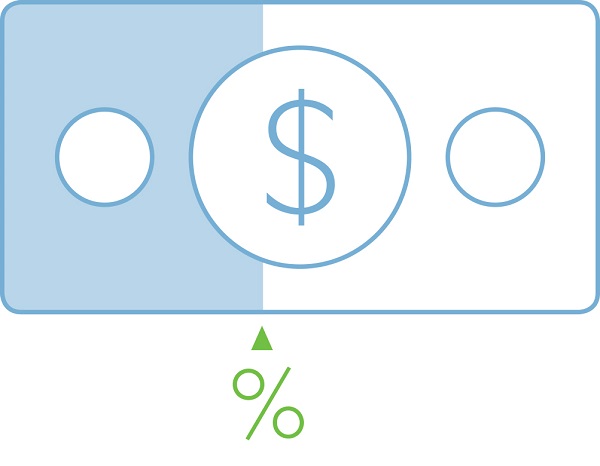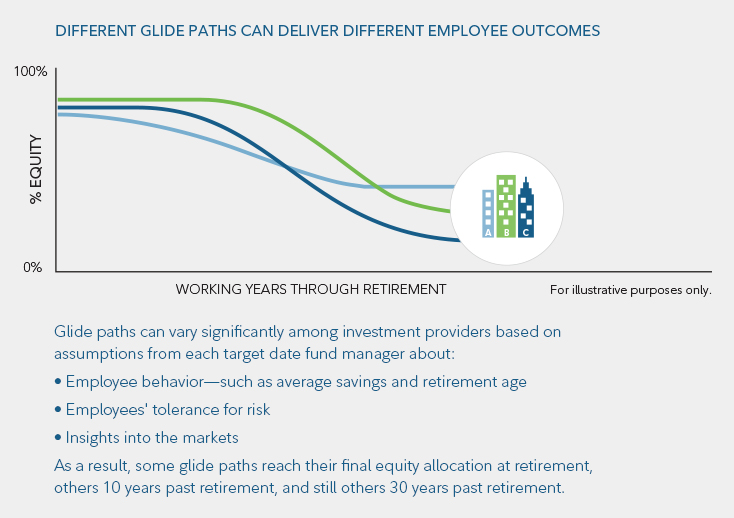Why is it important to align target date fund glide paths withretirement income goals? Employers today face significantchallenges in maintaining a competitive benefits program thatincludes helping employees achieve financial wellness inretirement. As fewer employers offer defined benefit plans, thereis an increasing reliance on defined contribution (DC) plans,placing the responsibility of saving and investing for retirementlargely on employees. This shift in responsibility for saving andinvesting for what could be 25–30 years in retirement has left manyemployees struggling and overwhelmed.
|Our research indicates:
Half of participants may not be invested appropriately fortheir age.1
More than half of all employees are likely not on track tocover their basic lifestyle expenses—health care, food, andhousing—in retirement.2
If employees are not on track to retire, employers may faceincreasing challenges in managing their workforce strategy.
|Leading employers are focused on designing plans forretirement income replacement. You can serve clients well by makingsure that they're thinking about income.

An increasing number of employers are taking a pension-likeapproach and designing DC plans with a targeted retirement incomereplacement level in mind, often stated as a percentage of aworker's final preretirement salary.
|With 6 in 10 workers relying on their DC plan as their primarysavings vehicle,3 designing one that generatessufficient income during retirement is critical. Progress is underway; the percentage of employers designing DC plans with a specificincome replacement goal rose to 18% in 2015, up from 4% in2013.4
|Saving and investing are both critical to achievingadequate income replacement.
|
5See disclosures for methodology and assumptions. Noincome replacement rate is guaranteed by any Fidelity target datefund.
|For employees, the combination of saving and investing iscritical to achieving an appropriate level of income replacement.As highlighted above, savings alone will only provide approximately6.5 years of retirement income for an employee who could live 25–30years or more in retirement. That's a significant shortfall.Educating participants on the proper savings amounts andappropriate investments is crucial to having enough money to lastthroughout retirement and maintain a desired standard ofliving.
||Ensure the goals of a DC plan and target date funds arealigned.
|As a default investment option, target date funds play acritical role in plan design. One important—and oftenoverlooked—consideration is ensuring that the target date fund'sunderlying assumptions and glide path, or strategic assetallocation, are aligned with a DC plan's income replacementgoal.
|
Employee dependence on target date funds means that yourplan sponsor clients should carefully evaluate the long-term goalsof their fund and their DC plan.
|No two target date fund glide paths arealike.
|For plan sponsors, selecting the appropriate target date fundand corresponding glide path in a DC plan is very much an activedecision, and requires the target date fund provider to offer fulltransparency into the glide path methodology and assumptions.Employers can serve their employees well by evaluating andmonitoring the glide path of the target date fund in their DC planto determine whether it was developed with specific key drivers inmind and derived through rigorous research and analysis.
|
Make sure your client's plan is designed to help drivebetter employee outcomes. Consider the following to help make sureplan design and investment choice are aligned:
Review DC plan design and use behavioral data to identify whereemployees need help. Consider implementing plan design features andinvestment choices that promote strong participation, highersavings rates, and appropriate asset allocation.
Make sure the DC plan and the glide path of the target date fundare designed with a similar income replacement goal. This alignmentcan help ensure a cohesive approach to retirement planning.
Ensure plan design and target date fund selection conversationshappen together. Bring together key stakeholders from across theorganization to align plan design and target date fund selectionwith retirement program goals.
Learn more about Fidelity target date funds and theimportance of income replacement in glide path design.Download charticle now.
|Before investing in any mutual fund, please carefullyconsider the investment objectives, risks, charges, and expenses.For this and other information, call or write Fidelity for a freeprospectus or, if available, a summary prospectus. Read itcarefully before you invest.
|Investing involves risk, including the risk ofloss.
|1Based on Fidelity analysis of 21,200 corporateDC plans (including advisor-sold DC) and 13.5 million participantsas of 6/30/2015. For “not age appropriately allocated” purposes,the participant's current age and equity holdings are compared withan example table containing age-based equity holding percentagesbased on an equity glide path. The Fidelity Equity Glide Path is anexample we use for this measure and is a range of equityallocations that may be generally appropriate for many investorssaving for retirement and planning to retire around ages 65 to 67.It is designed to become more conservative as participants approachretirement and beyond. The glide path as of 12/31/13 begins with90% equity holdings within a retirement portfolio at age 25continuing down to 24% equity holdings at age 93. Equities aredefined as domestic equity, international equity, company stock,and the equity option of blended investment options. The indicatorfor asset allocation is determined by being within 10% (+ or –) ofthe Fidelity Equity Glide Path and capped at 95% equity. We assumeself-directed account balances (if any) are allocated 75% toequities, regardless of participant age, so this indicator haslimited applicability for those affected participants. For purposesof this metric, participants enrolled in a managed account areconsidered to be age appropriately allocated. Diversificationand/or asset allocation do not ensure a profit or protect againstloss.
|2Fidelity Investments Retirement SavingsAssessment, 2015.
|3Participants in an Employment-Based RetirementPlan: Employee Benefit Research Institute, as of 2011.
|4Fidelity Investments online surveys of 500+employers; March 2013 and April 2015.
|5Chart is a hypothetical example based on a setof assumptions to illustrate the limits of income replacement thatcan be achieved through regular savings contributions alone (darkblue bars), and the need for an expected return on investment toachieve a desired level of income replacement over a longerretirement horizon (green bars). For the purposes of this chart,the following assumptions are presumed: investor startscontributing at age 25 through age 66, and receives annual salaryincreases equal to 1.5% over this period. Light blue bars representan increasing percentage of investor contributions from 8% to 13%of salary from age 25 through age 66 (includes company matchingfunds). Dark blue bars represent the expected income replacementprovided solely by the contribution amounts, equal to approximately50% of one's final preretirement salary through the early years ofretirement. Green bars represent the expected income replacementneeded through a target date portfolio's investment returns, equalto approximately 50% of one's final preretirement salary throughage 93. A hypothetical internal rate of return (IRR) equal toapproximately 4.5% in real terms is assumed (required investmentreturn to have savings equal income replacement needs). Thishypothetical illustration is not intended to predict or project theinvestment performance of any security or product. The IRR is arate of return used in capital budgeting to measure and compare theprofitability of investments. Past performance is no guarantee offuture results. Your performance will vary, and you may have a gainor loss when you sell your shares. For many investors, these assetswill be combined with other complementary sources of income (e.g.,Social Security, defined benefit plan benefits, and personalsavings). Source: Fidelity Investments.
|Target date funds are designed for investors expecting toretire around the year indicated in each fund's name. The funds aremanaged to gradually become more conservative over time as theyapproach the target date. The investment risk of each targetdate fund changes over time as the fund's asset allocation changes.They are subject to the volatility of the financial markets,including that of equity and fixed income investments in the U.S.and abroad, and may be subject to risks associated with investingin high-yield, small-cap, and foreign securities. Principalinvested is not guaranteed at any time, including at or after thefunds' target dates.
|For plan sponsor and institutional use only.
|Fidelity Institutional Services Company, Inc. 500 SalemStreet, Smithfield, RI 02917
|Fidelity Brokerage Services LLC, Member NYSE, SIPC, 900Salem Street, Smithfield, RI 02917
|©2016 FMR LLC. All rights reserved. 762863.2.0
|Complete your profile to continue reading and get FREE access to BenefitsPRO, part of your ALM digital membership.
Your access to unlimited BenefitsPRO content isn’t changing.
Once you are an ALM digital member, you’ll receive:
- Critical BenefitsPRO information including cutting edge post-reform success strategies, access to educational webcasts and videos, resources from industry leaders, and informative Newsletters.
- Exclusive discounts on ALM, BenefitsPRO magazine and BenefitsPRO.com events
- Access to other award-winning ALM websites including ThinkAdvisor.com and Law.com
Already have an account? Sign In
© 2024 ALM Global, LLC, All Rights Reserved. Request academic re-use from www.copyright.com. All other uses, submit a request to [email protected]. For more information visit Asset & Logo Licensing.








